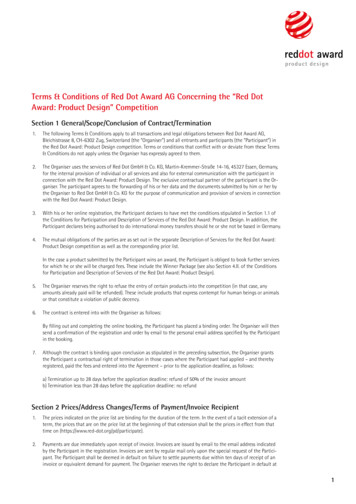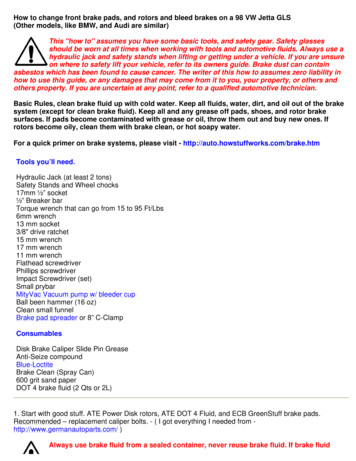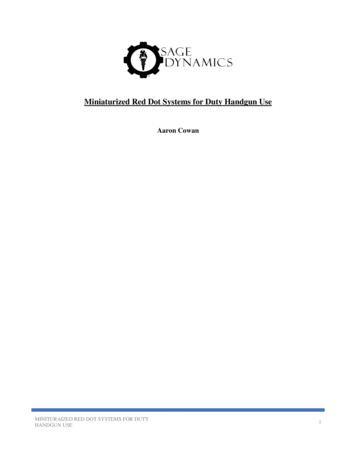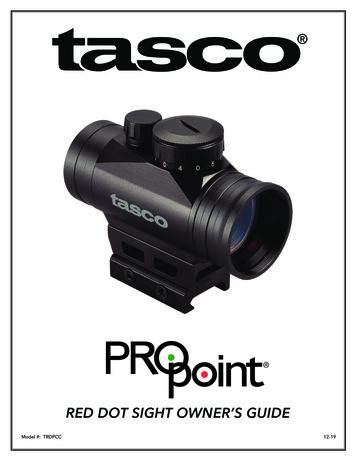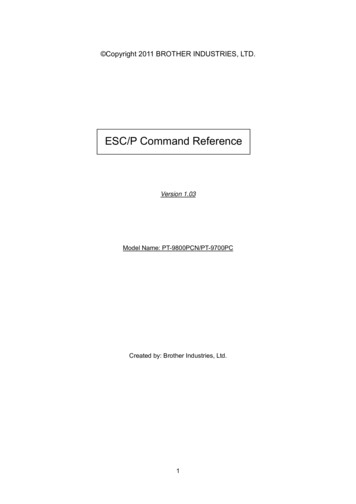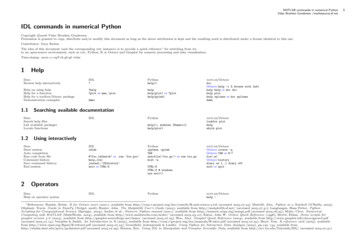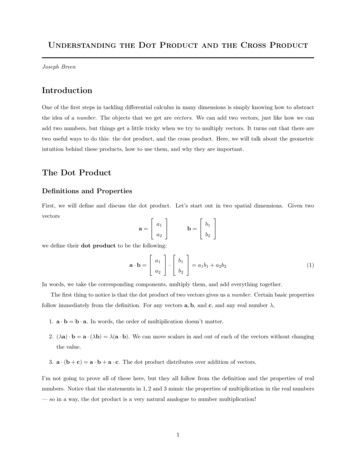
Transcription
Understanding the Dot Product and the Cross ProductJoseph BreenIntroductionOne of the first steps in tackling differential calculus in many dimensions is simply knowing how to abstractthe idea of a number. The objects that we get are vectors. We can add two vectors, just like how we canadd two numbers, but things get a little tricky when we try to multiply vectors. It turns out that there aretwo useful ways to do this: the dot product, and the cross product. Here, we will talk about the geometricintuition behind these products, how to use them, and why they are important.The Dot ProductDefinitions and PropertiesFirst, we will define and discuss the dot product. Let’s start out in two spatial dimensions. Given twovectors a a1a2 b b1b2 we define their dot product to be the following: a1b1 · a1 b1 a2 b2a·b a2b2(1)In words, we take the corresponding components, multiply them, and add everything together.The first thing to notice is that the dot product of two vectors gives us a number. Certain basic propertiesfollow immediately from the definition. For any vectors a, b, and c, and any real number λ,1. a · b b · a. In words, the order of multiplication doesn’t matter.2. (λa) · b a · (λb) λ(a · b). We can move scalars in and out of each of the vectors without changingthe value.3. a · (b c) a · b a · c. The dot product distributes over addition of vectors.I’m not going to prove all of these here, but they all follow from the definition and the properties of realnumbers. Notice that the statements in 1, 2 and 3 mimic the properties of multiplication in the real numbers— so in a way, the dot product is a very natural analogue to number multiplication!1
One more thing to note: recall that the norm / length / magnitude of a vector is defined to be thesquare root of the sum of the squared components. So if we take the dot product of a vector with itself, weget the square of the length of that vector:2a · a a21 a22 kakGeometric IntuitionThe algebraic properties of the dot product are important (and you should know them well!) but they’renot very interesting. Here’s what I would want to know if I were you: what does the dot product mean? Inother words, how can we interpret the value of the dot product geometrically?To tackle this question, I’m going to present an alternative (but equivalent!) way to define the dotproduct1 : given vectors a and b, let θ be the angle between them, and define their dot product to be:a · b kak kbk cos θ(2)This formulation of the dot product is conceptually nice for many reasons. For one, we can immediately seethat the dot product encodes information about the angle between two vectors. So, for example, ifwe’re given two vectors a and b and we want to calculate the angle θ between them, we can solve for θ in(2) to get: θ arccosa·bkak kbk The fact that the dot product carries information about the angle between the two vectors is the basis ofour geometric intuition. Consider the formula in (2) again, and focus on the cos θ part. We know that thecosine achieves its most positive value when θ 0, its most negative value when θ π, and its smallestmagnitude when θ π/2. Explicitly,cos π 1cosπ 02cos 0 1Geometrically, these particular angles correspond respectively to the following pictures:bbbaaaSo on the far left, when a and b are going in exactly opposite directions, the dot product will be as negativeas possible. In the middle case, when the vectors are perpendicular, the dot product will be 0.2 On the farright, when the vectors are heading in the same direction, the dot product will be as positive as possible.1 We2 Inreally should prove that these are equivalent formulations, but for the purpose of this discussion, I’ll let you believe me.fact, this is a complete characterization of perpendicularity, also called orthogonality. If a · b 0, then a and b areorthogonal.2
Summarizing this, we see that the dot product measures how similar two vectors are, or, how wellthey travel together. In other words, if they are parallel (i.e. traveling in the same direction), the dotproduct will be as big as possible (either negatively big or positively big), and if the vectors are perpendicular(and so don’t travel well together at all), the dot product will be zero. Also, consider the following: theargument above (which boils down to the fact that cos θ is always between 1 and 1) combined with equation(2) tells us that for any vectors a and b, kak kbk a · b kak kbk a · b kak kbk(3)This inequality is known as the Cauchy-Schwarz Inequality, and gives an alternate way to summarizewhat we talked about above.ProjectionsAs stated above, the dot product gives us a way to measure how similar two vectors are. The problem withthe dot product, though, is that it spits out a number. Sometimes we want a way to measure how wellvectors travel together while still preserving some information about direction. In other words, we want adot-product-like measurement that returns the same information as a vector rather than a scalar.How should we do this?Well, given vectors a and b, the quantity a · b measures how well they travel together. We could rephrasethis, use a as our “reference direction” and say that a · b measures how well b travels in the direction of a.Since we want to preserve information about the direction we’re travelling in, we can just multiply a · b bythe vector a!(a · b) aThe only issue here is that the length of a is going to mess up our measurement, so to be safe, we shouldinstead multiply the dot product by a unit vector in the a direction:(a · b)akakWe could improve on one more thing. Since a is our reference direction, we (again) don’t want the length ofa messing up our measurements. So we could normalize the coefficient of our vector by dividing once moreby the length of a:a·b aa·ba·b 2 a a·a akak kakkakCool! This is a normalized-vector-version of the dot product. We give this measurement a special name:the projection of b onto a:proja b a·b aa·b akak kaka·a(4)The reason this is called the projection is because it has a very nice geometric interpretation: givenvectors a and b, proja b gives a vector that represents the component of b in the a direction. In other words,if we smashed down b directly on top of a, proja b is the vector that we get:3
bbproja baaAlternatively, the vector projb a smashes a directly onto b and gives us the component of a in the bdirection:bbprojb aaaIt turns out that this is a very useful construction. For example, projections give us a way tomake orthogonal things. By the nature of “projecting” vectors, if we connect the endpoints of b withits projection projb a, we get a vector orthogonal to our reference direction a. In other words, the vectorb projb a is orthogonal to a:bbbb projb aaaproja bproja baSo projections give us one way to construct perpendicular directions. If we need a normal vector, aperpendicular bisector, the shortest distance between a point and a line, etc., we can use projections!One last thing about the dot product. We started this discussion under the assumption that our vectorswere two dimensional. But (other than the fact that vectors in two dimensions are easy to visualize) wenever really used this fact! We could just as easily define the dot product for n-dimensional vectors a and b: a1b1 a 2 b2 a·b . · . a1 b1 a2 b2 · · · an bn . . anbnThe pictures will be hard (and even impossible) to visualize if n is big, but the same properties hold. Also,if n 1 (so that a and b are just numbers) we get regular multiplication! Pretty cool.4
The Cross ProductMotivationNow it’s time to talk about the second way of “multiplying” vectors: the cross product. Defining this methodof multiplication is not quite as straightforward, and its properties are more complicated. But the crossproduct is an extremely powerful tool, and understanding it well will pay off.First, I want to provide some motivation for the cross product, because at first glance the definition willseem rather ugly and arbitrary. So having developed the theory of the dot product, here are some interestingquestions we might ask:1. Duality to the Dot Product: We have a product that measures how similar two vectors are (thedot product). Can we construct a product that measures how different (i.e. perpendicular) twovectors are?2. Area: Given two vectors a and b, they define a parallelogram:baCan we construct an “area product”? In other words, can we multiply a and b in a way that gives usthe area of the parellelogram they span?3. Orthogonality: We have a vector product that returns a scalar (the dot product). Can we define auseful product that returns a vector ? In particular, since we know that orthogonality is a nice property,can our product return a vector that is orthogonal to both a and b?3a “times” b?baEach of these questions will be good to keep in mind as we move forward, because the cross product is theanswer to all of them!Alright, take a deep breath, because here we go:3 Notethat this only makes sense in at least 3 dimensions.5
DefinitionFor the cross product, we are going to restrict ourselves to three spatial dimensions (so even if we only careabout vectors in two dimensions, we can view them in three dimensions by adding a 0 in the last component).So let a and b be vectors in R3 . We define their cross ba1 1 a b a2 b2 b3a3product to be: a b a3 b2 2 3 a3 b1 a1 b3 a1 b2 a2 b1 (5)As I mentioned, this is not a very easy definition to digest. Unfortunately, this is something that you’llhave to memorize and learn to work with — but I promise, it does make sense! It just takes some time andpractice to get the intuition.Here’s an alternative way to remember the definition, using the determinant of a matrix. Recall that thestandard vectors in three dimensions are i, j, and k:4 1 i 0 0 0 j 1 0 0 k 0 1To calculate the cross product of a and b, we can make a 3 3 matrix with i, j, and k across the top row,the components of a across the middle row, and the components of b across the bottom row. Then, take itsdeterminant:5a b ijka1a2a3b1b2b3a2 b3 a3 b2 a3 b1 a1 b3 a1 b2 a2 b1 (a2 b3 a3 b2 )i ( 1)(a1 b3 a3 b1 )j (a1 b2 a2 b1 )k There are a number of ways to memorize the formula for the cross product — this is just one of them.Before we list the algebraic properties of the cross product, take note that unlike the dot product, thecross product spits out a vector. This alone goes to show that, compared to the dot product, the crossproduct is a different kind of beast.Before we get to the interesting part of interpreting the meaning of the cross product, we need to know howto work with it algebraically:4 You5 Heremight see these referred to as e1 , e2 , and e3 .we are using what is known as Laplace Cofactor Expansion across the top row.6
PropertiesLet a, b, and c be vectors in three dimensions, and let λ be a real number. Then the following holds:61. a b (b a). In words, the order does matter ! Calculating b a gives us a vector in the oppositedirection as a b.2. (λa) b a (λb) λ (a b). Just like with the dot product, we can move scalars in an out of eachvector.3. a (b c) a b a c. The cross product distributes across vector addition, just like the dotproduct.Like the dot product, the cross product behaves a lot like regular number multiplication, with the exceptionof property 1. The cross product is not commutative.There are a lot of other algebraic properties and identities that can be uncovered using the definition,but the ones listed above are the most important.Geometric IntuitionNow it’s time to understand what the cross product represents geometrically. We will use the three motivatingquestions at the beginning of the section to guide us. Let’s tackle these one by one:1. Duality to the Dot Product: The cross product acts as a sort of dual to the dot product in thatit measures how different two vectors are, rather than how similar they are. More formally, the crossproduct provides a way to measure orthogonality: the more orthogonal a and b are, the longer thecross product a b will be.Remember the formula a · b kak kbk cos θ? The similarity of a and b was encapsulated in the cos θ,where θ represented the angle between the two vectors. So if the cross product represents the “dual”measurement to the dot product, we can use the “dual” to cos θ: sin θ! It turns out that we can calculatethe length of the cross product vector a b in the following way:ka bk kak kbk sin θ(6)The biggest (in magnitude) sin θ gets is when θ π/2, 3π/2, where sin θ 1, 1 respectively. In otherwords, the cross product achieves its largest magnitude when a and b are orthogonal. The smallest (inmagnitude) that sin θ gets is when θ 0, π, where sin θ 0. This occurs when a and b are parallel.Cool!6 Likebefore, I won’t prove all of these here. They are a straightforward, albeit tedious, consequence of the definition.7
2. Area: The previous discussion should make a lot of sense in the context of area. Consider the picturebelow:bbaaBecause of the fact that the area of a parallelogram is the length of the base times the vertical height,it shouldn’t be hard to convince yourself that the rectangle on the left has more area than the parallelogram on the right. In other words, the more orthogonal a and b are, the larger amount of areathey span! This is really just a reinterpretation of the discussion in question 1. The cool part is thatthe cross product let’s us actually calculate the exact area of the parallelogram. Not coincidentally, itis the formula in (6):Area of parallelogram spanned by a and b ka bk kak kbk sin θNote that it follows immediately that a a 0 for all vectors a, since one vector cannot determine aparallelogram!73. Orthogonality: The first two questions dealt with the length of the cross product, but it’s importantto keep in mind that a b is a vector. As it turns out, a b is a vector that is orthogonal to botha and b!8 In other words, a b is a vector normal to the parallelogram spanned by a and b. Whilethis is pretty cool, there is one small complication: given two vectors a and b, there are two possibledirections that cross product could go. We could have a normal vector that sticks out either “above” or“below” a and b:a b?baa b?So which one is it?Recall the first property of the cross product:a b (b a)7 Wecould prove this using the definition (it isn’t hard), but the geometric implications of the cross product give us aconceptually nice argument for why this is true.8 Explicitly: (a b) · a (a b) · b 0. Again, we could prove this using the definition.8
Again, this means that changing the order of multiplication gives us a vector in the opposite direction.That means that, in the picture above, one of the vectors will be a b and the other will be b a.Which one is which? This is where the right hand rule comes in. In calculating a b, take yourright hand, curl your fingers starting at a and in the direction of b. The direction that your thumbpoints is the direction of a b! Next, b a: take your right hand, curl your fingers from b to a. Noticethat your thumb points downwards, in the opposite direction of a b. This completes our picture:a bbab a (a b)So the a b is orthogonal to both a and b, and its direction is determined by the right hand rule.These three questions demonstrate the usefulness of the cross product: a b measures the area spanned bya and b (and thus encodes their perpendicularity), and produces a vector that is orthogonal to both a andb.Some ApplicationsThe Scalar Triple ProductHere, we’re going to put both the dot product and the cross product to use. Any three vectors a, b, and cin three dimensions determine a parallelepiped (i.e. a three dimensional parallelogram-like box), just likehow any two vectors determine a parallelogram:cbaLet’s calculate the volume of this parallelepiped. We know that the formula for the volume of a parallelepipedis:V (area of base) (vertical height)9(7)
Note that the base is the parallelogram spanned by a and b. We just learned how to calculate this area!The area of the base is exactly the length of the cross product: ka bk. So equation (7) becomes:V ka bk (vertical height)Next, we need to calculate the vertical height of the parallelepiped. In other words, we need to calculatethe component of c in the direction perpendicular to the base. Explicitly, we want the component of c in thedirection of a b. This should ring a bell: projections. In particular, we want the length of the projectionof c onto a b!a bproja b ccbaSo let’s recall how to calculate that projection:proja b c (a b) · c a bka bk ka bkThis is just an application of projection formula in (4). What we want is the vertical height, which is justthe magnitude of this vector:proja b c (a b) · c a b (a b) · c ka bk (a b) · c ka bk ka bkka bk ka bkka bkTherefore, the volume of the parallelepiped spanned by vectors a, b, and c is:V ka bk proja b ka bk (a b) · c (a b) · c ka bk(8)Cool! We used both the cross product and the dot product to prove a nice formula for the volume of aparallelepiped: V (a b) · c . The product that appears in this formula is called the scalar tripleproduct:(a b) · cOne last comment: there was nothing special about that fact that we chose the base of our parallelepipedto be determined by a and b — we could calculate this volume in any order we want!V (a b) · c (a c) · b (b c) · a Note that this is because we’re taking the absolute value of the number we get from the scalar triple product.Since it contains a cross product, switching the order could change the sign of the scalar triple product itself.10
Calculating Shortest DistancesLet’s do one more application of both the dot product and the cross product. Here’s a motivating question:given a point P and a line L , what is the shortest distance from P to L ?LPGeometrically, the distance d we want is indicated by the dashed line below. Note that the dashed lineis perpendicular to L :PLdSo if we can find a vector that goes from P to the intersection of the dashed line with L , we can takethe length of that vector! Here’s the gameplan: first, pick any two points on L , R and S.9 Then, construct the vectors a RP P R and b RS S R:LPdLPdSabRThe diagram on the right looks very similar to the projection diagram on page 4. If we calculate theprojection of a onto b, then calculate a projb a, this is exactly the vector that we want!See the diagram below:9 Ifthe equation for L is given as a parametric equation, you can do this by picking two arbitrary values of t.11
ajbproLa Pbaprojb aTherefore, the shortest distance from P to L is exactly d ka projb ak.We just used projections (and so indirectly, the dot product) to calculate the shortest distance from P toL . Alternatively, we could use the cross product! Here’s how:Note that our two vectors a and b define a parallelogram:LPdbaAs we now know, the area of this parallelogram is ka bk. Alternatively, the area of any parallelogramis the length of the base times the vertical height. If we make the base of the parallelogram the vector b,the vertical height is exactly d! This tells us that:Area (Length of Base)(Vertical Height) kbk dBut we also know that:Area ka bkTherefore,ka bk kbk d d ka bkkbkThe cross product gives us an alternative (and perhaps slicker) way to calculate this minimum distance.12
a b a b proj a b Alternatively, the vector proj b a smashes a directly onto b and gives us the component of a in the b direction: a b a b proj b a It turns out that this is a very useful construction. For example, projections give us a way to



